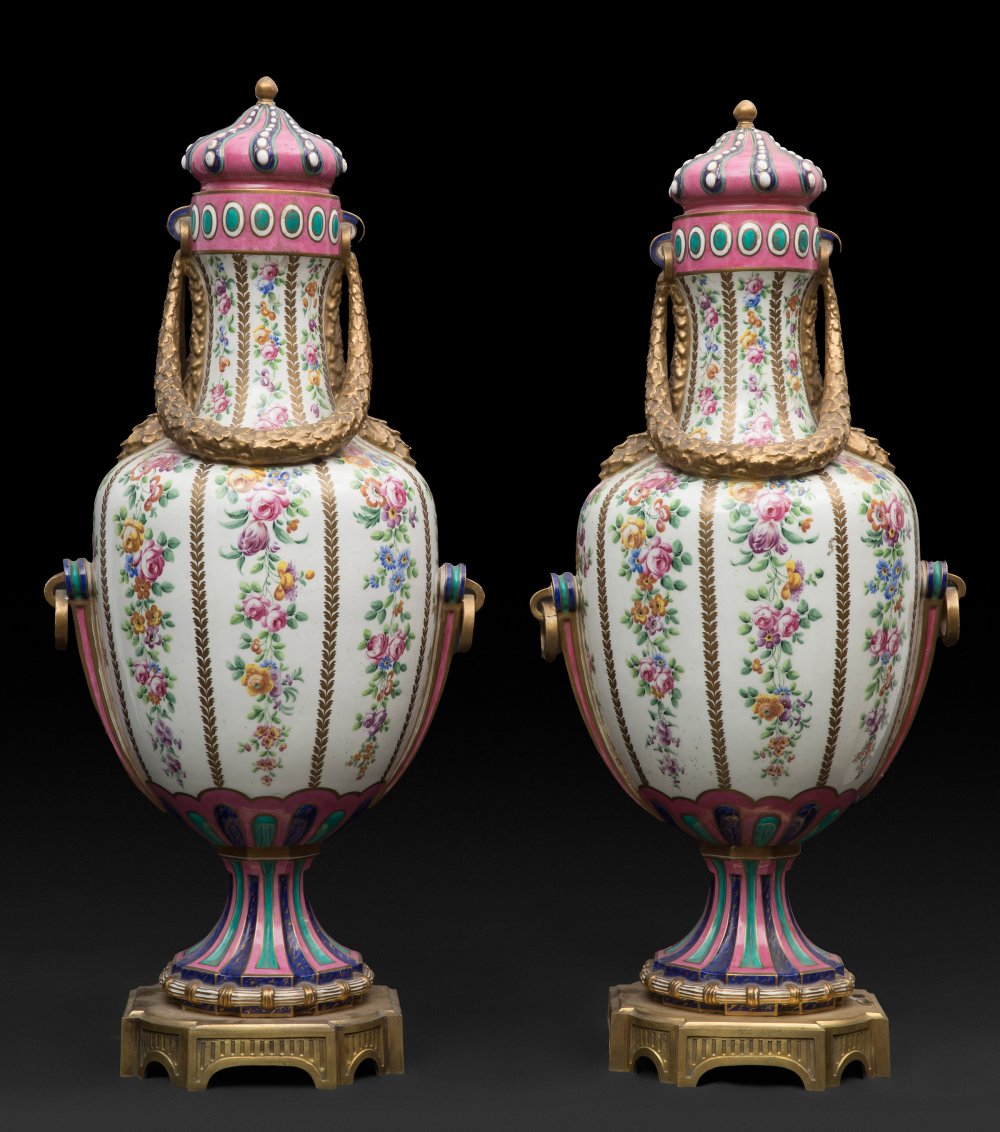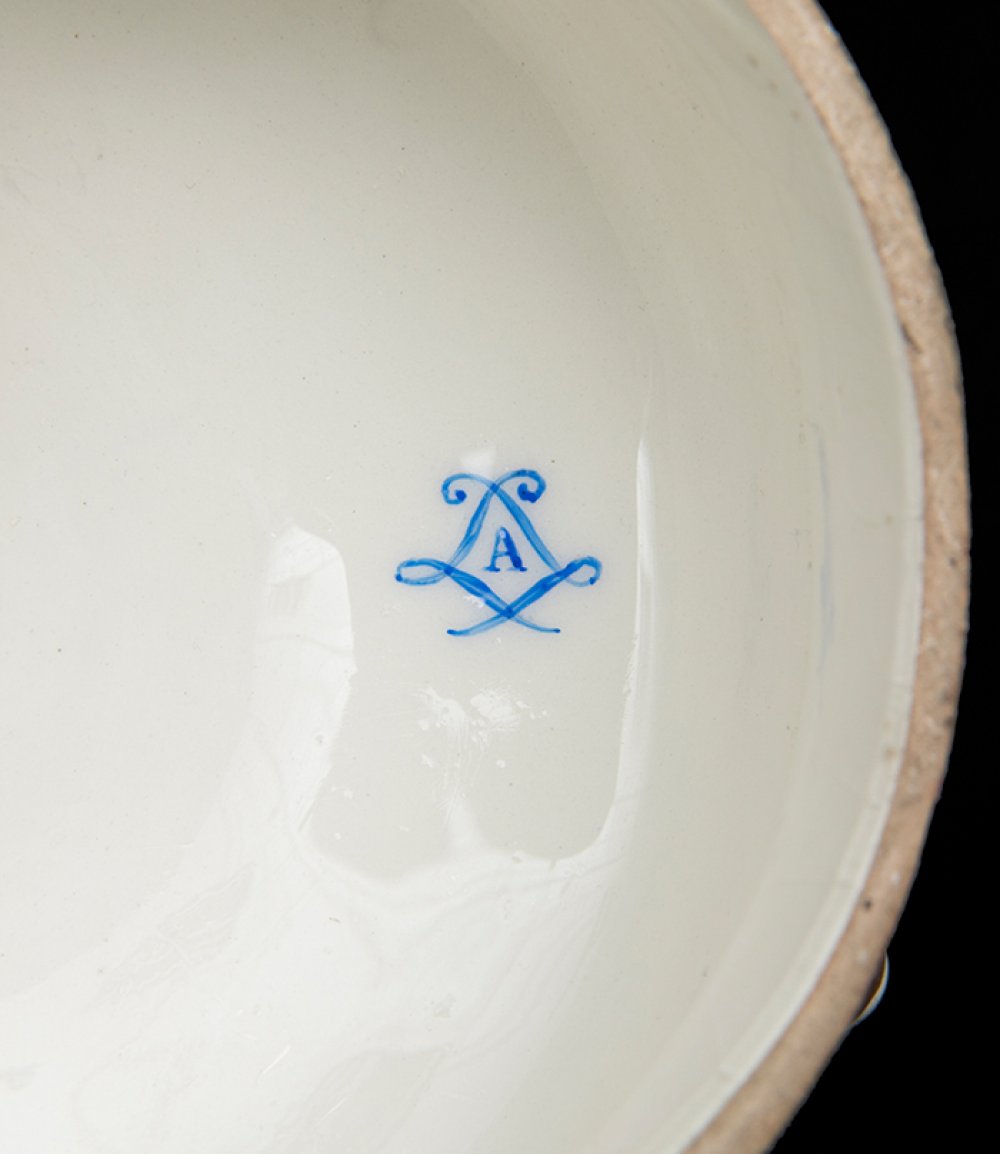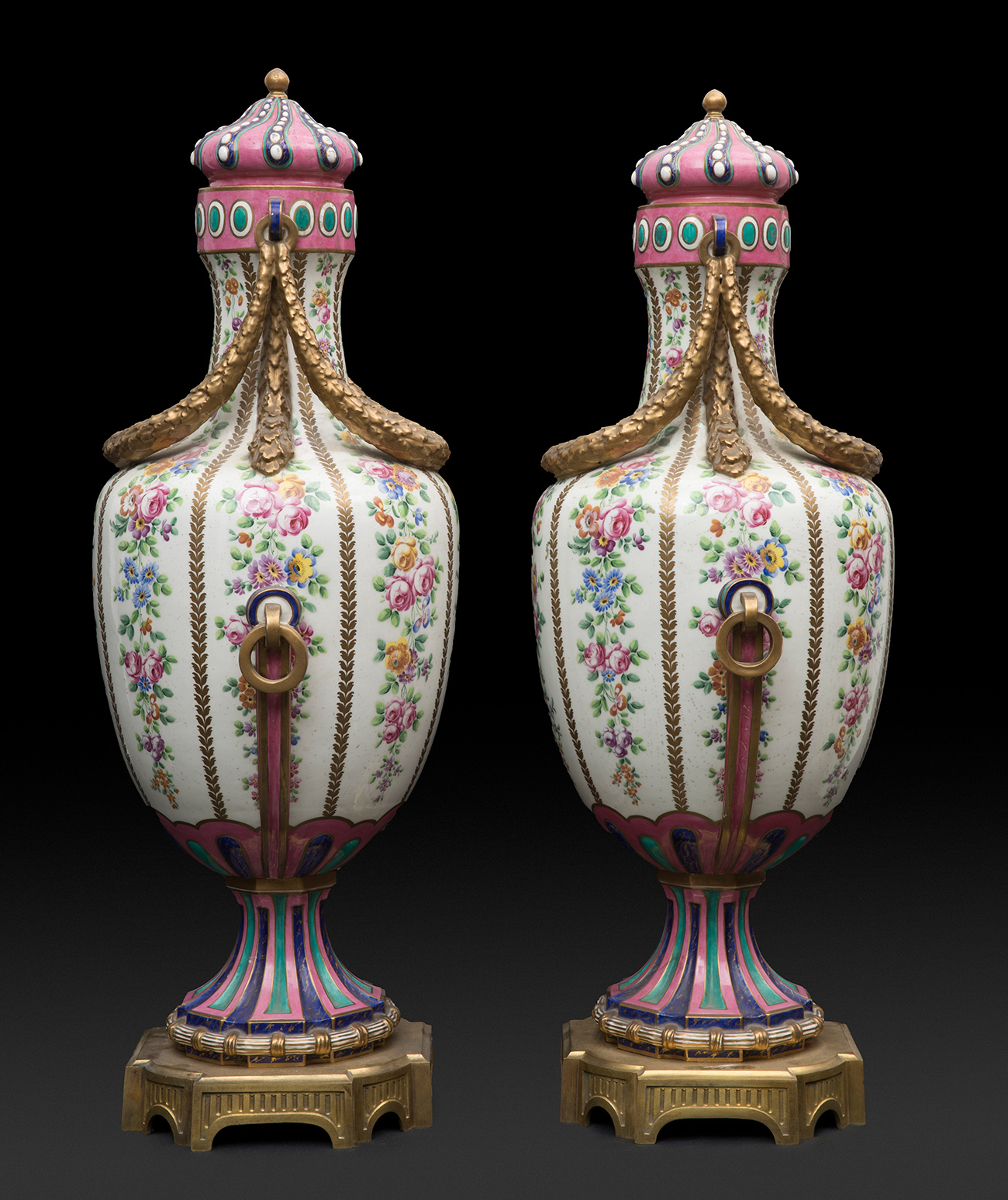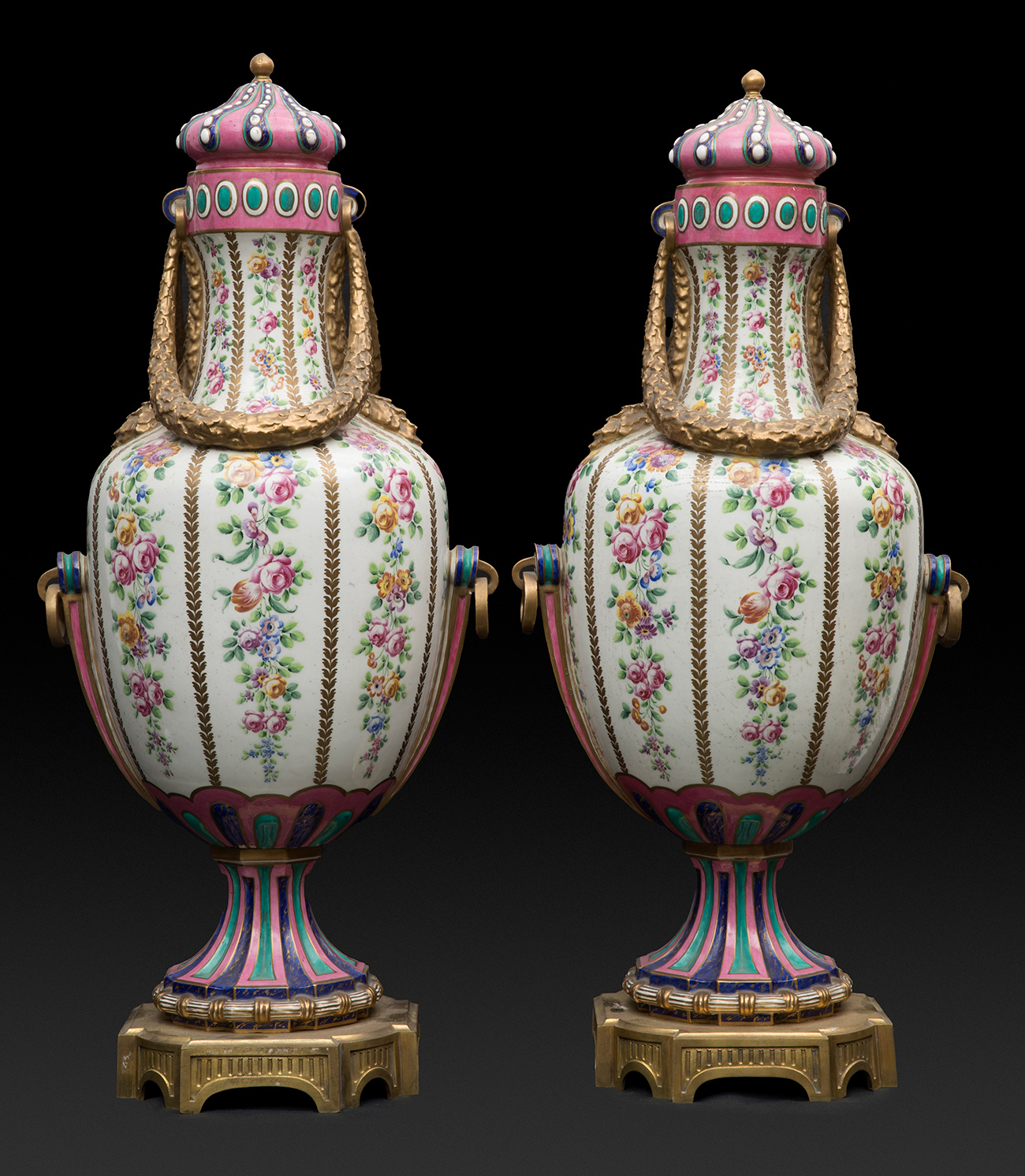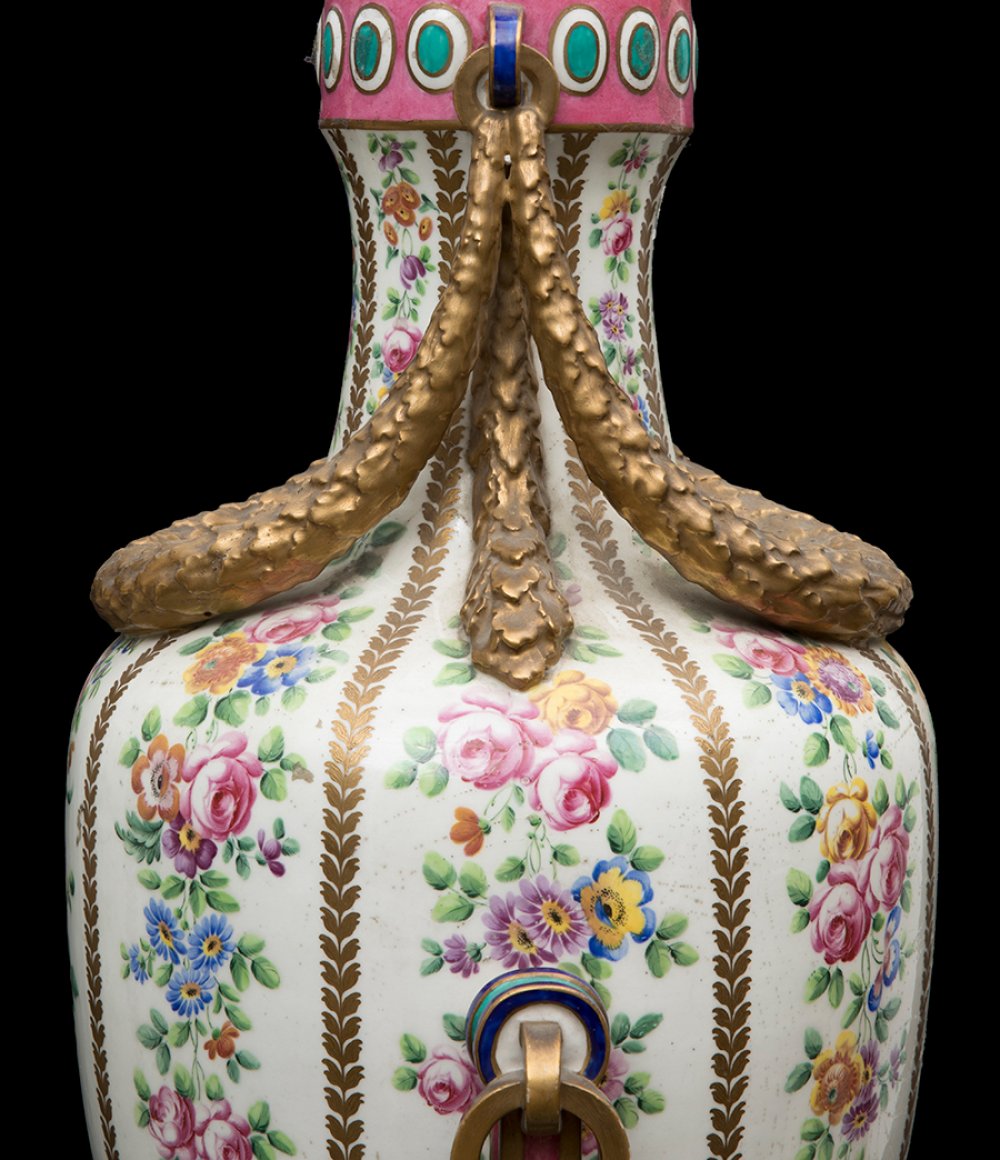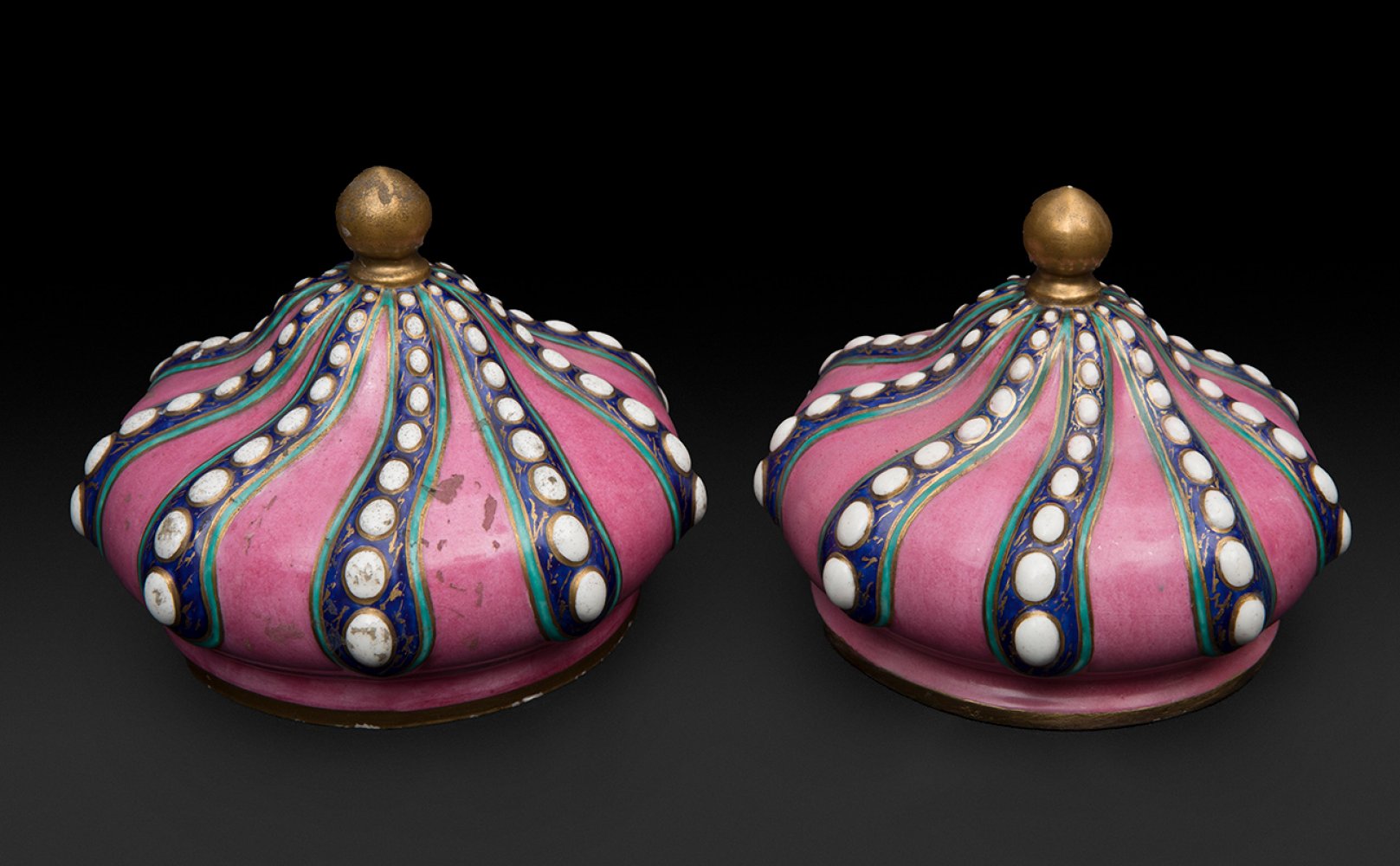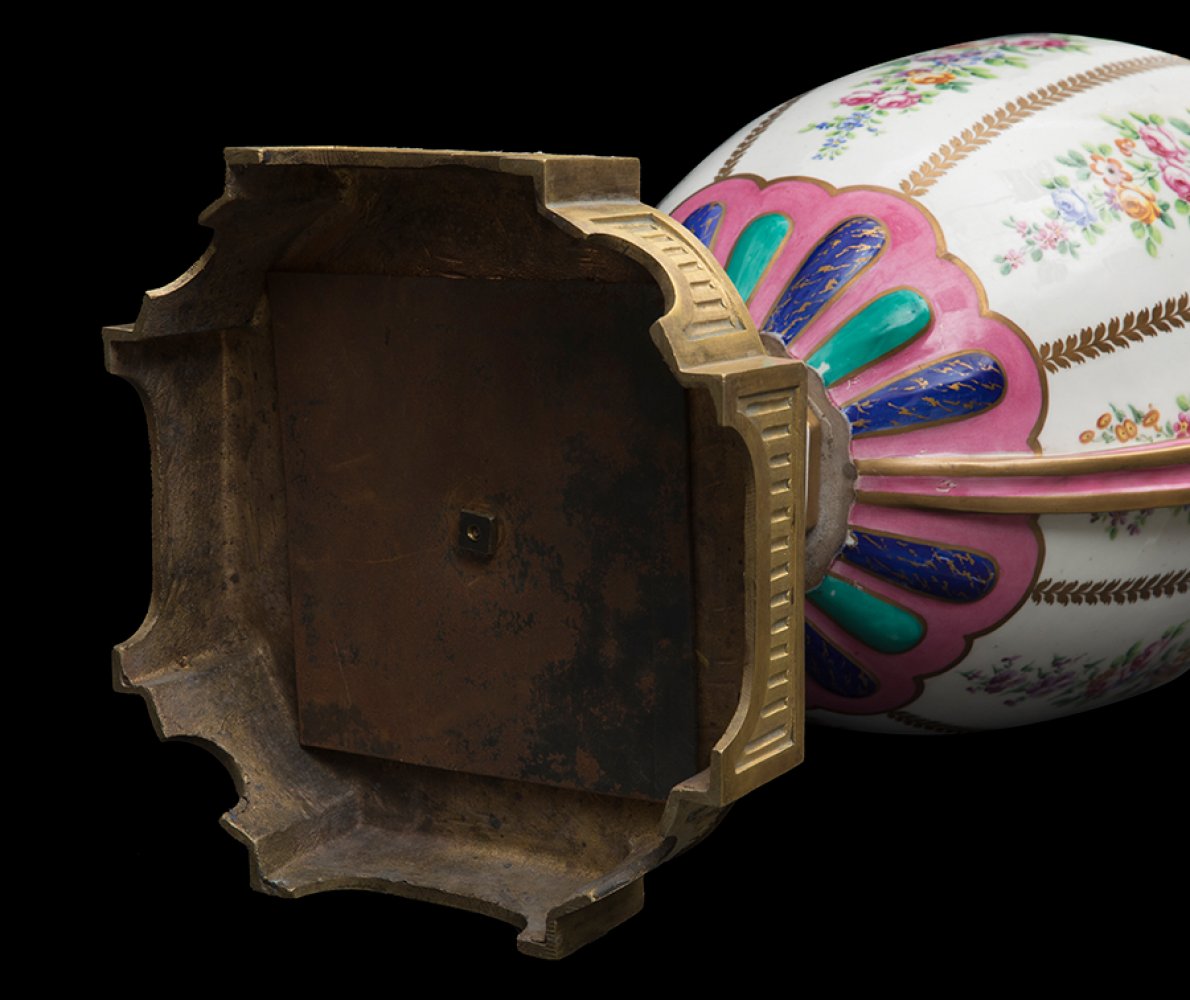13
Pair of Sévres vases; second half of the 19th century.Porcelain and gilt bronze bases.Marks on the
Porcelain and gilt bronze bases.
Marks on the lid.
Measurements: 81 x 38 x 30 cm (vases, x2): 5,5 x 25 x 25 cm (bases, x2).
Pair of ornamental vases made of porcelain. The typology refers to classical vases, a key reference point for Western porcelain since the Renaissance and especially during the Neoclassical and Empire periods. However, the author has taken certain artistic licences, avoiding the strict rigidity of classical forms. Both pieces have the same structure resting on a polygonal bronze base, and both are based on a round base in a combination of different shades of blue, pink and violet, arranged in intercalated stripes. The body has a spherical structure, although flattened at the top, with small handles on the sides and a floral ornamentation that is structured in the form of farms in the shape of gadroons, which extend up to the neck, where a large bronze garland falls.
Originally founded in Vincennes in 1740, the Manufacture Nationale de Sèvres was transferred to Vincennes in 1756. One of the leading European porcelain factories, the Manufacture was successively named after different political regimes: royal, imperial and national manufactory. Still active today, the firm continues to produce objects created since 1740, although its current production is largely oriented towards contemporary creation. The Manufacture de Vincennes was founded with the support of Louis XV and Madame de Pompadour, with the idea of creating pieces for the court and competing with the porcelain productions of Meissen and Chantilly. In fact, the first experiments were carried out by the brothers Robert and Gilles Dubois, who came from the Chantilly manufactory. By 1745, under the direction of the Gravant couple, important results had already been achieved, in particular the creation of models of porcelain flowers to decorate all kinds of pieces. The new building in Sèvres, where the manufactory moved in 1756, was built on the initiative of Madame de Pompadur. Three years later, it was designated a royal factory, and from that time onwards it was the only one in France to use fine gold. In its early years, the factory produced mainly soft paste; hard porcelain, with kaolin, was not marketed in Sèvres until 1770. Among the innovations of this manufactory in the 18th century were coloured backgrounds and the use of biscuit for small sculptures. During the French Revolution, the factory suffered a decline in production, but experienced a revival between 1800 and 1847 under the direction of Alexandre Brongniart, who brought the factory international fame. During these years, many important technical innovations were made, and a number of contemporary artists collaborated with the manufacture. A new type of gilding was introduced at this time, which was made shiny by burnishing the surface with an agate stone. The pieces were also decorated with opaque gilding, which was done by rubbing the gold with very fine sand. It was at this time that, for ornamental vases, a cartouche became established as the central theme, in the manner of an oil painting, with a gilt cartouche on a monochrome background. From the mid-19th century onwards, the dominant styles were eclecticism and historicism, and some models revived typologies from the past, such as the Mannerism of Fontainebleau and the Baroque of Versailles.
Porcelain and gilt bronze bases.
Marks on the lid.
Measurements: 81 x 38 x 30 cm (vases, x2): 5,5 x 25 x 25 cm (bases, x2).
Pair of ornamental vases made of porcelain. The typology refers to classical vases, a key reference point for Western porcelain since the Renaissance and especially during the Neoclassical and Empire periods. However, the author has taken certain artistic licences, avoiding the strict rigidity of classical forms. Both pieces have the same structure resting on a polygonal bronze base, and both are based on a round base in a combination of different shades of blue, pink and violet, arranged in intercalated stripes. The body has a spherical structure, although flattened at the top, with small handles on the sides and a floral ornamentation that is structured in the form of farms in the shape of gadroons, which extend up to the neck, where a large bronze garland falls.
Originally founded in Vincennes in 1740, the Manufacture Nationale de Sèvres was transferred to Vincennes in 1756. One of the leading European porcelain factories, the Manufacture was successively named after different political regimes: royal, imperial and national manufactory. Still active today, the firm continues to produce objects created since 1740, although its current production is largely oriented towards contemporary creation. The Manufacture de Vincennes was founded with the support of Louis XV and Madame de Pompadour, with the idea of creating pieces for the court and competing with the porcelain productions of Meissen and Chantilly. In fact, the first experiments were carried out by the brothers Robert and Gilles Dubois, who came from the Chantilly manufactory. By 1745, under the direction of the Gravant couple, important results had already been achieved, in particular the creation of models of porcelain flowers to decorate all kinds of pieces. The new building in Sèvres, where the manufactory moved in 1756, was built on the initiative of Madame de Pompadur. Three years later, it was designated a royal factory, and from that time onwards it was the only one in France to use fine gold. In its early years, the factory produced mainly soft paste; hard porcelain, with kaolin, was not marketed in Sèvres until 1770. Among the innovations of this manufactory in the 18th century were coloured backgrounds and the use of biscuit for small sculptures. During the French Revolution, the factory suffered a decline in production, but experienced a revival between 1800 and 1847 under the direction of Alexandre Brongniart, who brought the factory international fame. During these years, many important technical innovations were made, and a number of contemporary artists collaborated with the manufacture. A new type of gilding was introduced at this time, which was made shiny by burnishing the surface with an agate stone. The pieces were also decorated with opaque gilding, which was done by rubbing the gold with very fine sand. It was at this time that, for ornamental vases, a cartouche became established as the central theme, in the manner of an oil painting, with a gilt cartouche on a monochrome background. From the mid-19th century onwards, the dominant styles were eclecticism and historicism, and some models revived typologies from the past, such as the Mannerism of Fontainebleau and the Baroque of Versailles.
16th November - Decorative Arts
Sale Date(s)
Venue Address
General delivery information available from the auctioneer
Setdart offers Worldwide shipping
PICK UP IN ROOM: You can come and pick up your lots in our offices (Barcelona, Madrid or Valencia). At the moment of the withdrawal, you will be able to accept the current conditions of the lot by means of a document that you will sign.
YOU CAN SEND ANOTHER PERSON TO PICK UP: This person must present a signed authorization that you can find in our web page by accessing from BUY AT SETDART- LOGISTICS-DOWNLOAD AUTHORIZATION DOCUMENT. You can also send an e-mail with the requested data in AUTHORIZATION DOCUMENT to admin@setdart.com
Important Information
25% buyer´s premium
Terms & Conditions
The maximum period to pay the lots is 7 working days. You can pay either via bank transfer or with credit card through our platform www.setdart.com (we only accept VISA or Mastercard).
BUYER´S PREMIUM: 22% Hammer price + 21% VAT from the buyer´s premium
If your piece has more than 100 years, our Ministry of Culture requires an export certificate in order for the piece to leave the country. Note that if the piece goes inside the EU, there is no cost for the export certificate. If the piece goes outside the EU, there is a cost for the export certificate. You can find more information in our Ministry of Culture website: https://www.culturaydeporte.gob.es/en/cultura/patrimonio/exportacionimportacion/exportacion/tasas.html
INQUIRIES: admin@setdart.com
Setdart guides you through the entire process, from the time of award to the day you receive your lot. Our logistics team will be happy to manage your transport, and will advise you on the best shipping method with professionals from the sector used to handling works of art and jewelry.
WE OFFER WORLDWIDE DOOR TO DOOR SHIPPING
PICK UP IN ROOM: You can come and pick up your lots in our offices. At the moment of the withdrawal, you will be able to accept the current conditions of the lot by means of a document that you will sign.
YOU CAN SEND ANOTHER PERSON TO PICK UP: This person must present a signed authorization that you can find in our web page by accessing from BUY AT SETDART-LOGISTICS-DOWNLOAD AUTHORIZATION DOCUMENT. You can also send an e-mail with the requested data in AUTHORIZATION DOCUMENT to admin@setdart.com
SETDART IS NOT RESPONSIBLE FOR THE STATE OF THE PARTS ONCE THEY LEAVE OUR FACILITIES. MRW SHIPMENTS: Once the payment is made, your lot will be packed for shipment, the logistics department will send you an e-mail notifying you of the day it leaves our warehouse, changes of address cannot be made after receiving this e-mail.
INSURANCE INCIDENTS: Coverage for the value of the auction up to 3000 ? per shipment, if the value of the auction is higher, Setdart will send you a quote including the additional insurance. The insurance company WILL NOT BE RESPONSIBLE FOR THE SHIPMENT THAT EXCEEDS THAT AMOUNT AND IS NOT FULLY INSURED. MRW INCIDENTS: Maximum notification 48 hours after receipt, after which the insurance company WILL NOT BE RESPONSIBLE AND NO CLAIMS WILL BE ACCEPTED.
E-MAIL LOGISTICS: logistica@setdart.com
PICK UP YOUR MESSAGES: You can send your own messaging, prior notice via e-mail that your shipment is ready, please note 3 or 4 days in advance. This type of shipment is packaged so Setdart will provide you with a quote.
EXPENSES FOR STORAGE: We inform you that if the purchased lot is not picked up within a month, you will be charged 30€ per week per lot. Setdart Online S.L., owner of the web site "setdart.com", "setdart.net" and "setdart.org", acts as a company of Spanish nationality inscribed in the Volume 36955, sheet 182, page B-293056 of the Mercantile Registry, with registered office at Calle Aragó















